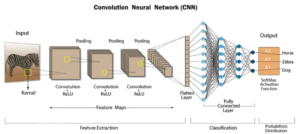Deep learning and neural networks have become buzzwords in recent years, revolutionizing various fields like computer vision, natural language processing, and even finance. But what exactly are they, and how do they work? This introductory guide aims to demystify these fascinating concepts with clear explanations and helpful visuals.
1. Unveiling the Brain’s Inspiration: Artificial Neural Networks
Imagine a network of interconnected nodes inspired by the human brain. This is the core concept behind an artificial neural network (ANN). These networks consist of:
- Neurons: Basic units that receive inputs, perform calculations, and generate outputs. Think of them as the bricks of the network.
- Layers: Groups of interconnected neurons arranged in layers. The network’s depth refers to the number of layers.
- Weights and Biases: Parameters that determine the strength of connections between neurons and influence the network’s output.
- Activation Functions: Introduce non-linearity to the network, allowing it to learn complex patterns.
2. Learning from Data: Training the Neural Network
Deep learning algorithms train the network by adjusting weights and biases based on a large amount of data. This process involves:
- Gradient Descent: An iterative algorithm that minimizes the loss function, guiding the network towards better accuracy. Imagine a ball rolling downhill towards the lowest point, representing the optimal solution.
- Backpropagation: Computes the gradient of the loss function with respect to weights and biases, enabling their efficient update. Think of it as tracing the ball’s path and understanding how each step contributed to reaching the bottom.
3. Optimizing the Journey: Boosting Learning Efficiency
Several techniques help optimize the learning process, ensuring the network learns effectively:
- Momentum: Provides a “push” in the right direction, accelerating the learning process.
- Adaptive Learning Rates: Adjust the learning rate dynamically, preventing the network from getting stuck in local minima.
- Regularization: Techniques like weight decay and dropout prevent overfitting, allowing the network to generalize better to unseen data.
4. Delving Deeper: Advanced Deep Learning Concepts
As you progress, you’ll encounter specialized architectures and techniques:
- Convolutional Neural Networks (CNNs): Designed for image recognition, they use filters to extract spatial features and identify patterns.
- Recurrent Neural Networks (RNNs): Ideal for sequential data like text and speech, they have internal memory that captures context and dependencies.
- Long Short-Term Memory (LSTM): A specific type of RNN that excels at learning long-term dependencies in sequences, enabling effective processing of lengthy text or speech.
- Generative Adversarial Networks (GANs): Two competing neural networks, one generating data (generator) and the other trying to distinguish it from real data (discriminator). This adversarial process allows for the creation of realistic images, music, and other creative content.

5. Transforming the World: Real-world Applications of Deep Learning
Deep learning has found its way into various aspects of our lives:
- Computer Vision: Object recognition, self-driving cars, medical image analysis.
- Natural Language Processing: Machine translation, chatbots, sentiment analysis.
- Speech Recognition and Synthesis: Voice assistants, text-to-speech generation, automated transcription.
- Healthcare: Personalized medicine, drug discovery, disease prediction.
- Finance: Fraud detection, algorithmic trading, risk assessment.
6. The Future of Deep Learning: Ongoing Developments and Potential
Deep learning is a rapidly evolving field with immense potential to further revolutionize our world. Current research areas include:
- Explainable AI (XAI): Making deep learning models more transparent and understandable.
- Neuromorphic Computing: Developing hardware specifically designed for deep learning algorithms.
- Deep Reinforcement Learning: Enabling agents to learn through trial and error, paving the way for advanced robotics and automation.
Conclusion: Deep learning and neural networks offer a powerful tool for tackling complex problems across diverse domains. This introductory guide has provided a foundation for understanding these concepts, inspiring further exploration and discovery in this exciting field.



